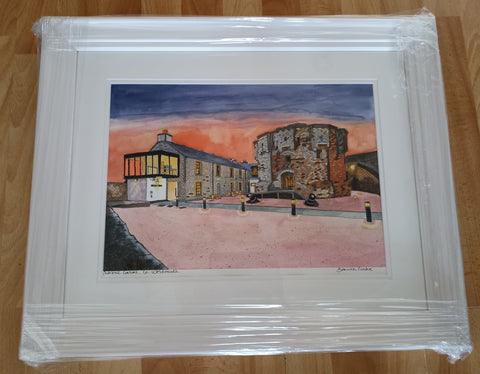
Athlone Castle, standing majestically on the banks of the River Shannon in County Westmeath, is a monument to Ireland's tumultuous history. From its early days in the 13th century to its strategic military enhancements in the 19th century, the castle has been a key player in the defence and development of the region.
The site of Athlone Castle has always been critical for controlling access across the River Shannon into Connacht. Historical records, including the Annals of the Four Masters, suggest the O'Connor Clan of Connacht first fortified this location. King Toirrdelbach Ua Conchobair is credited with constructing the initial stronghold in 1129, marking the beginning of the site's storied past.
Instructed by King John of England, John de Gray initiated the construction of the present castle in 1210, aiming to solidify the English presence in Connacht. However, tragedy struck when a tower collapse claimed lives, including that of Richard de Tuite, the Lord Chief Justice of Ireland. This disaster led to a robust rebuild and the castle's maintenance became a priority, ensuring its resilience in the face of adversity.
The early 14th century brought the Scottish invasion of Ireland, known as the Bruce Invasion, causing significant upheaval. Athlone Castle, caught in the crossfire, was attacked and the town was burned by Ruaidri na bhFeadh ó Conchobair, King of Connacht. This period of conflict saw the castle change hands multiple times, symbolizing the ongoing struggle between Irish and English powers.
Athlone Castle's military significance peaked in the late 16th and early 17th centuries, serving as the residence of the Presidents of Connaught and facing numerous assaults, including those led by James Fitzmaurice Fitzgerald and Hugh O’Neill. Despite these challenges, Athlone developed into a thriving merchant town, fortified to withstand the turbulence of the times.
The 1641 Confederacy Rebellion saw Athlone Castle besieged, a precursor to Oliver Cromwell's campaign in Ireland. The castle played a pivotal role in the administration of Cromwell's harsh policies, including the infamous resettlement of Catholic farmers to Connacht. However, with the restoration of Charles II, Athlone's strategic importance waned.
The late 17th century reignited Athlone's military role during the Williamite Wars. The castle withstood a significant siege in 1690 before falling to Williamite forces in 1691, despite heroic defence efforts. This loss preluded the Battle of Aughrim, marking a turning point in the war and in Athlone's history.

After years of ruin, Athlone Castle was revitalized in the 18th and 19th centuries, prepared to defend against potential French incursions during the Napoleonic Wars. Today, it stands as a testament to Ireland's rich history, housing a visitor centre that brings its past vividly to life.
Athlone Castle's journey from a medieval fortress to a modern historical site encapsulates the ebb and flow of Irish history. Its walls have witnessed the rise and fall of dynasties, the horrors of war, and the resilience of a people determined to protect their land. A visit to Athlone Castle is not just a step back in time; it's an immersion into the heart of Ireland's storied past.

